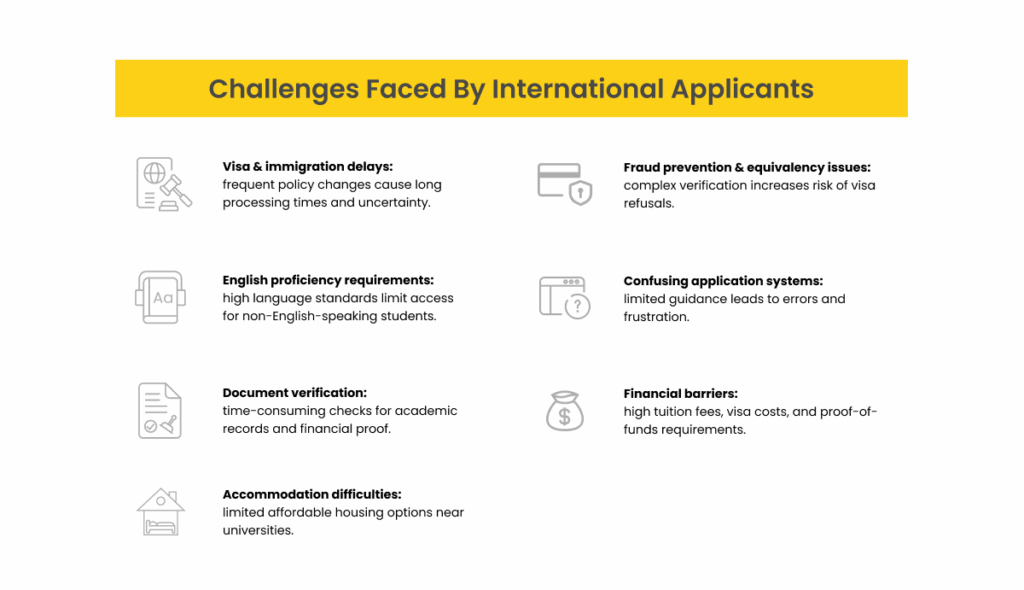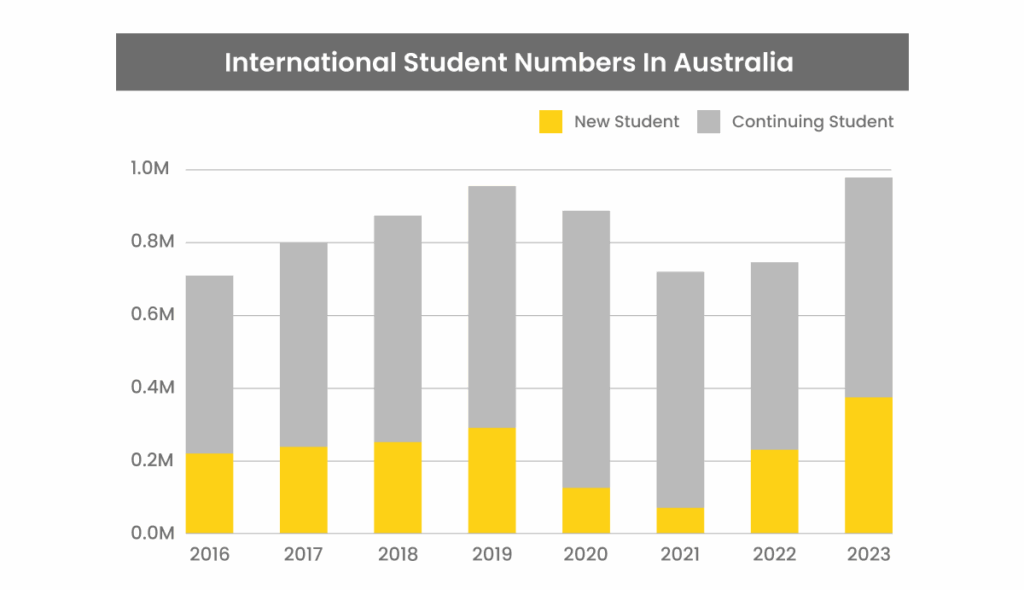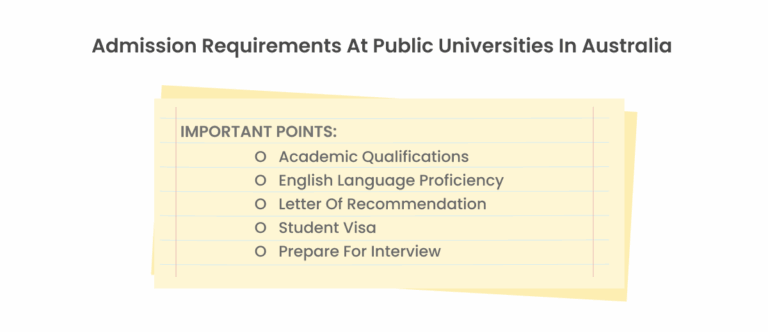Australian education institutions regularly face a range of challenges when admitting international students. Changes introduced by the Australian government to visa and immigration procedures can affect processing times and lead to long waiting periods, negatively impacting enrolments. High-level English proficiency requirements for student visas also make it more difficult for students from non-English-speaking countries to gain admission.
In addition, document verification, equivalency processes and fraud prevention are among the major obstacles. Checking academic transcripts and financial capacities can be slow and complex, which increases the risk of visa refusals if there are any inconsistencies. Complex application systems and insufficient guidance offered to applicants can also cause confusion as they try to complete the admission process.
Many students also face financial and accommodation difficulties. High tuition fees, visa charges and proof-of-funds requirements make studying in Australia very expensive. On top of that, finding affordable housing near universities can be difficult, adding further stress to the admissions process.

Challenges and Barriers Faced by International Students Applying to Australian Universities
Frequent changes in visa and immigration policies, including the limitation of student visa numbers, have made things uncertain and complicated for international students. Higher English language proficiency requirements for Australian student visas (for example, higher IELTS scores) are another barrier for many people. Strict document verification processes aimed at preventing fraud have made applications more difficult, because universities now carefully examine academic records, financial proof and other documents, this is also a legal requirement. Managing the application and admission process is difficult and stressful, the absence of a centralised system and limited official guidance cause students to rely on education agents. High costs are another obstacle, international tuition fees in Australia are high and student visa application fees have increased in recent years. In addition, the housing shortage in Australia’s major cities means that there is not enough affordable accommodation for students.
Handling Large Numbers of Applications from a Wide Range of Students
Australian universities receive a high number of applications from both domestic and international students every year. Applicants range from recent graduates to mature-age students and international students with different academic backgrounds, therefore each application pathway has its own requirements, which makes the assessment process more complex. Administrative staff must verify academic documents, check prerequisites, and evaluate eligibility under different admission schemes. Coordinating these across multiple faculties and departments increases the workload on administrative staff.
Limited staffing and increasing administrative demands make this challenge even greater. During peak periods admissions teams must process applications quickly and accurately and issue offers on time, all while managing multiple systems and tight deadlines. Managing this complexity requires student management systems to play an important role, in addition to which integrated workflows and strong interdepartmental communication also help.

Documentation Requirements and Verification Processes
International students are required to provide certified academic transcripts, degree certificates with English translations if necessary, and proof of English proficiency such as official IELTS, TOEFL or PTE results. They also usually submit identification documents such as a passport and financial capacity documents such as bank statements or sponsorship letters to show that they can cover tuition and living expenses. Australian universities and visa authorities carefully check these documents through secure digital platforms, sealed transcripts or authorized credential services to prevent fraudulent records. These verification steps may cause the admission process to take longer. Waiting for official documents or external checks can take weeks, and missing or questionable documents can delay or even stop an application. Therefore, most admission letters are issued conditionally, depending on the verification of all documents, which means that all issues must be resolved before enrollment. Overall, these s

Improving How Applications Are Managed
Australian universities are updating their admissions management processes by using student management systems and enrolment platforms that consolidate all applicant information and automate routine tasks. These digital tools simplify tasks such as checking eligibility, tracking documents and enrolling students, reducing paperwork and errors. Through SMS, staff are able to make faster decisions and manage multiple applications at the same time. Universities also use these platforms to send applicants automatic updates and reminders, making the process more transparent and user-friendly. With support options such as live chat, email and online portals, applicants can get their questions answered quickly, while monitoring dashboards help student services track the progress of applications. These improvements enable universities to process applications more quickly and securely, providing international students with a smoother experience. By using these technologies, universities are better prepared to confiden
Student Visa and Immigration Challenges in Australia
Student visa issues in Australia are now a serious problem for both students and schools. Visa processing has become much slower and more unpredictable than before. As of early 2024, nearly 20% of offshore student visa applications were being refused, mostly due to missing documents. Many qualified students are waiting 10 to 12 months or even longer for a decision. As a result, more students are deferring or completely withdrawing their enrolments. One of the main reasons for the high refusal rates is financial barriers. In recent years, financial barriers have increased. These financial barriers are affecting all universities in Australia. Schools such as the University of Sydney and the University of Melbourne have had to extend enrolment deadlines or allow students to arrive late because many are still waiting for visa decisions. These delays have now become a problem for university planning and for attracting international students.
Complex Student Visa Requirements (GTE and Financial Proof)
Australia’s student visa requirements contain serious conditions for students and are subject to strict scrutiny. This new framework requires applicants to prove beyond doubt that their primary intention is to study, not to migrate,resulting in more in-depth examination and higher rejection rates. At the same time, financial proof requirements have significantly increased in recent years. Australia’s student visa requirements, especially with the transition from the GTE (Genuine Temporary Entrant) rule to the new ‘Genuine Student’ test in March 2024, continue to be among the most strictly enforced and detailed systems in the world.
Dealing with Higher Visa Fees and Longer Processing Times
Visa fees have gone up big time in Australia. Non refundable even if the visa is refused. A major issue for many students applying for short term or language programs. And it’s starting to affect student choices and number of international students. For example some students are choosing other countries instead of Australia and language school enrolments have dropped by over 50% according to reports.
Changes in Immigration Policies and Enrolment Quotas
Since the pandemic, there has been a sharp increase in the number of international students in Australia; in 2023/24, education exports reached approximately 50 billion Australian dollars. This growth has drawn the attention of government officials. Australia has implemented a managed enrolment system for international students, which uses measures such as limiting new admissions and enforcing stricter visa rules. To be accepted into the country, students must now demonstrate that they meet specific educational standards, which are generally expected to be equivalent to an Australian high school diploma.The Australian government may update immigration admission quotas each year based on factors such as housing supply, labour demand, and infrastructure capacity.
Academic and English Language Requirements for Admission to Australian Universities
All applicants must also meet English language requirements. Most universities require an IELTS score between 6.0 and 6.5. For example, the University of Sydney requires an overall IELTS score of 6.5, with no band below 6.0; equivalent scores in TOEFL, PTE, or Cambridge tests are also accepted. More competitive programs such as law or medicine may require higher scores. From 2025 onwards, the Australian Government accepts a wide range of approved English tests for visa purposes, including IELTS, TOEFL iBT, PTE Academic, OET, CELPIP, and Cambridge. However, each university sets its own score requirements for admission.
Universities and colleges often offer English language courses (ELICOS) or short classes to help students prepare for IELTS or PTE exams. For example, Macquarie University, through Open Universities Australia, provides free online IELTS preparation modules covering reading, writing, listening, and speaking. Across Australia, the Study Australia website also offers free practice tools such as speaking practice tests for IELTS or PTE. In general, it is recommended that students practice regularly with official sample questions and get feedback from teachers or study groups.
Cultural Adjustment and Access to Student Support
Adapting to a new culture can be difficult, but universities and local communities have resources to help with this. Schools often organise orientation and cultural events extensively and have international student offices to assist with daily inquiries. Clubs, mentors, and buddy programs within the university help reduce culture shock and feelings of loneliness. Many campuses have staff or peer groups from specific cultural backgrounds so that students can find their own communities. Moving to a new country is a major change, but the Australian system offers many ways for international students to access support and feel included. Adjusting takes time, so experts recommend arriving early, attending orientation, and visiting the international student office for help with academic expectations and daily life. Making use of campus support networks and social opportunities is important for overcoming culture shock and succeeding in Australia.
Coping with Social Isolation and Mental Health Issues
Many international students are likely to feel isolated, stressed, or anxious after moving to a new country. Factors such as loneliness, being away from family, language barriers, and high academic or work pressure trigger these problems. Research shows that international students in Australia may be at higher risk of mental health issues. Other common sources of stress include academic pressure, financial concerns, and adapting to a new culture. Mental health problems are also common; up to 43% of students experience anxiety and up to 38% experience depression during their studies.
Australian universities are aware of these challenges, and most have counseling centers or health services that provide mental health support, usually free or at a reduced cost. Some universities also run workshops or peer support groups. However, stigma and lack of information prevent some students from seeking help. It is important for students to use these resources early. Many universities explain how to access counseling, spiritual guidance, or international student advisors. Students are also encouraged to build social connections through clubs, study groups, or volunteering.
Coping with isolation and mental health requires both university support and personal effort for example, asking for help and staying connected. The main advice is to get involved and seek help before problems grow, as universities have many resources to support student wellbeing.






